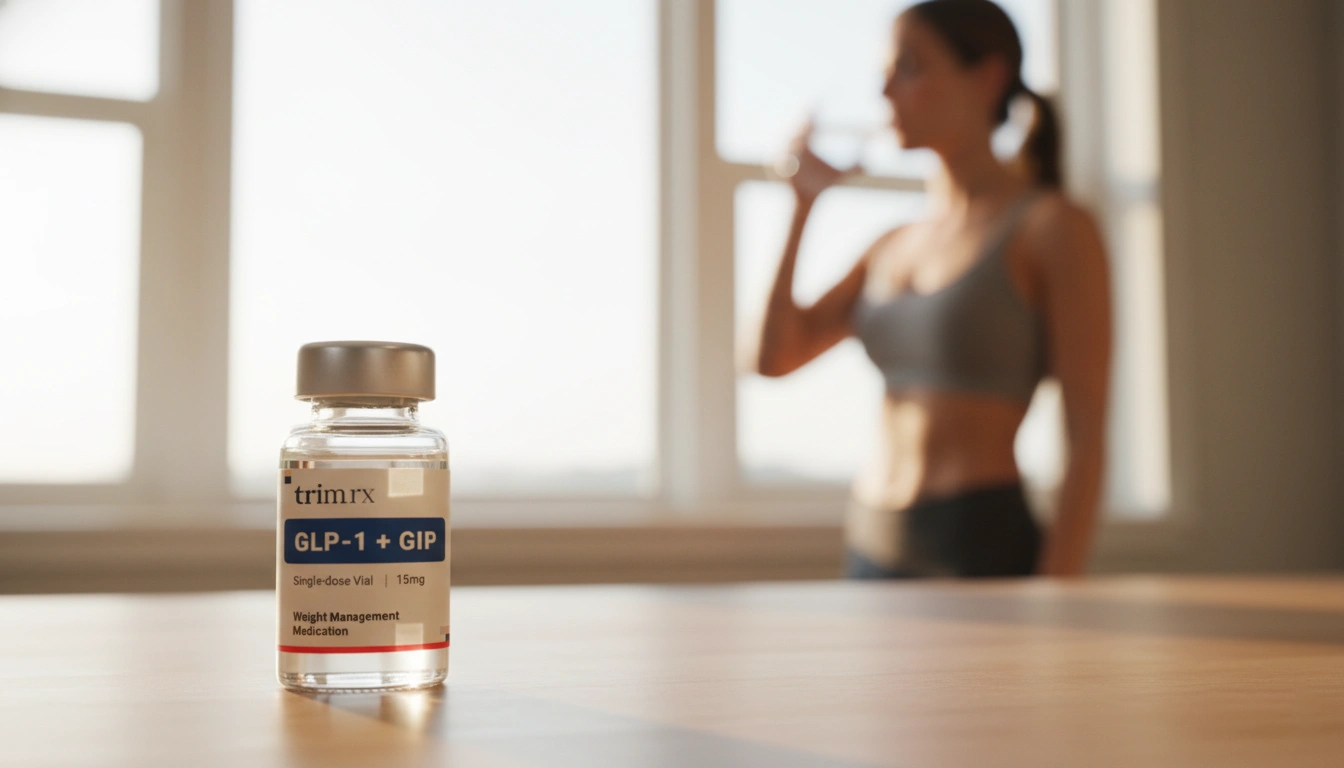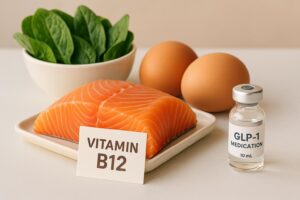How to Mimic GLP-1 Naturally for Effective Weight Management

Introduction
Did you know that a powerful hormone in your body can play a significant role in how you manage weight and regulate appetite? This hormone, called glucagon-like peptide-1 (GLP-1), has garnered attention not just among researchers, but also in the realm of weight loss solutions.
GLP-1 is naturally produced in the gut and is released in response to food intake, helping to stimulate insulin release, slow digestion, and promote feelings of fullness. As our understanding of GLP-1 deepens, so does our awareness of its potential impact on weight management and metabolic health. With the rise of GLP-1 medications like semaglutide (Ozempic, Wegovy) and tirzepatide (Mounjaro, Zepbound), many individuals are looking for natural ways to enhance their GLP-1 levels without pharmaceuticals.
In this blog post, we will explore how to mimic GLP-1 naturally through dietary choices, lifestyle changes, and gut health optimization. We aim to provide you with actionable insights and practical strategies that you can incorporate into your daily life. By the end of this post, you will have a clearer understanding of how to enhance your body’s natural GLP-1 production and why this hormone is essential for weight management.
We’ll cover topics such as the role of diet in GLP-1 production, the significance of fiber and certain foods, the impact of exercise, and the importance of gut health. Additionally, we will delve into how TrimRx’s personalized weight loss solutions can support you on your journey to achieving and maintaining a healthier lifestyle, combining science with empathy and individualized care.
Understanding GLP-1: The Hormone Behind Appetite Regulation
GLP-1 is part of a group of hormones known as incretins, which are released by the gut in response to food intake. Its primary functions include:
- Stimulating Insulin Release: GLP-1 prompts the pancreas to release insulin when blood sugar levels rise after eating, helping to lower glucose levels in the blood.
- Slowing Gastric Emptying: By slowing down the rate at which food leaves the stomach, GLP-1 helps to maintain stable blood sugar levels and prolongs feelings of fullness.
- Reducing Appetite: GLP-1 communicates with the brain to signal satiety, effectively reducing the desire to eat more.
- Inhibiting Glucagon: This hormone counteracts the effects of glucagon, which tends to raise blood sugar levels, hence helping to keep blood sugar levels in check.
Research shows that individuals with obesity often experience a reduced response to GLP-1, which can lead to increased hunger and difficulty in managing weight. Understanding how to naturally stimulate GLP-1 production can be a game-changer in weight management.
The Importance of Diet in GLP-1 Production
Diet plays a crucial role in GLP-1 secretion. Certain foods can enhance GLP-1 levels, contributing to better appetite regulation.
Foods That Boost GLP-1 Levels
-
High-Fiber Foods: Fiber is one of the most effective dietary components that can enhance GLP-1 secretion. When we consume fiber, it is fermented by gut bacteria, producing short-chain fatty acids (SCFAs) that stimulate GLP-1 release. Foods high in dietary fiber include:
- Whole grains (oats, barley, brown rice)
- Fruits (apples, bananas, berries)
- Vegetables (broccoli, Brussels sprouts, carrots)
- Legumes (beans, lentils)
-
Protein-Rich Foods: Protein can also help increase GLP-1 levels. Foods such as eggs, fish, poultry, and nuts provide a good source of protein. Research indicates that protein-rich meals can lead to greater GLP-1 secretion compared to carbohydrate-heavy meals.
-
Healthy Fats: Foods rich in healthy fats, such as avocados, olive oil, and nuts, can positively influence GLP-1 secretion. Monounsaturated fats have been shown to promote satiety and support insulin sensitivity.
-
Fermentable Fibers: Certain types of fibers, such as beta-glucan found in oats and barley, have been shown to significantly boost GLP-1 levels. Adding these fibers to your diet can be an effective way to mimic GLP-1’s appetite-suppressing abilities.
-
Natural Supplements: Some natural supplements may also play a role in enhancing GLP-1 secretion. For example, berberine, a compound found in various plants, has been associated with improved glucose metabolism and increased GLP-1 levels.
The Role of Exercise in GLP-1 Secretion
In addition to dietary choices, physical activity is another powerful tool for boosting GLP-1 levels. Studies have shown that both acute and chronic exercise can increase GLP-1 secretion.
-
Aerobic Exercise: Engaging in regular aerobic exercise, such as walking, running, cycling, or swimming, has been shown to enhance insulin sensitivity and promote GLP-1 release. Aim for at least 150 minutes of moderate-intensity aerobic exercise per week.
-
Resistance Training: Incorporating resistance training into your fitness routine can also support GLP-1 production. Strength training helps build muscle mass, which can improve metabolic health and contribute to better GLP-1 response.
-
High-Intensity Interval Training (HIIT): Short bursts of high-intensity exercise followed by periods of rest may further enhance GLP-1 secretion and improve overall metabolic health.
The Gut Microbiome and GLP-1 Production
The gut microbiome—the diverse community of bacteria and microorganisms living in our intestines—plays a significant role in GLP-1 production. A balanced gut microbiome can enhance the fermentation of dietary fibers, leading to increased SCFA production and, consequently, higher GLP-1 levels.
-
Prebiotics: These are non-digestible fibers that feed beneficial gut bacteria. Foods rich in prebiotics, such as garlic, onions, leeks, asparagus, and bananas, can promote a healthy gut microbiome and support GLP-1 production.
-
Probiotics: Introducing probiotics, which are live beneficial bacteria, can help maintain a balanced gut microbiome. Foods like yogurt, kefir, sauerkraut, and kombucha are excellent sources of probiotics.
-
Avoiding Processed Foods: A diet high in processed foods can negatively impact gut health, leading to dysbiosis (an imbalance of gut bacteria) and decreased GLP-1 production. Opting for whole, unprocessed foods can help promote a healthier gut environment.
TrimRx’s Personalized Weight Loss Solutions
At TrimRx, our journey began with a shared vision to help individuals embrace healthier lifestyles. We believe that sustainable weight loss should be achieved through science, empathy, and a transparent approach. Our personalized weight loss programs merge cutting-edge telehealth innovations with effective solutions designed specifically for you.
Our approach includes:
- Comprehensive Assessments: We offer a free assessment quiz to determine your eligibility for personalized prescription weight loss medications, such as compounded semaglutide, oral semaglutide, and more. This helps us create a tailored treatment plan that meets your unique needs.
- Doctor Consultations: Our medically supervised programs include consultations with qualified healthcare professionals ensuring you receive the support and guidance you need throughout your weight loss journey.
- Unlimited Support: We provide ongoing support to help you stay on track, making your weight loss journey a collaborative experience.
- Quick-Access Supplements: For those looking for immediate support, our GLP-1 Daily Support and Weight Loss Boost supplements are available for purchase, designed to complement your weight loss efforts.
Conclusion
Mimicking GLP-1 naturally through dietary choices, exercise, and gut health optimization can be an effective strategy for managing appetite and supporting weight loss efforts. By incorporating fiber-rich foods, protein, healthy fats, and engaging in regular physical activity, we can enhance our body’s natural GLP-1 production.
At TrimRx, we are committed to supporting you on your journey towards a healthier lifestyle. Our personalized weight loss programs provide you with the comprehensive care and guidance needed to achieve sustainable results.
As you consider how to apply these insights into your own life, we encourage you to take our free assessment quiz to see if you qualify for our prescription weight loss medications. Together, we’ll explore the best strategies for enhancing your health and well-being.
FAQ
What is GLP-1 and why is it important for weight management?
GLP-1 is a hormone released by the gut in response to food intake. It plays a critical role in regulating appetite, stimulating insulin release, and slowing gastric emptying, making it essential for effective weight management.
How can I naturally increase my GLP-1 levels?
You can enhance GLP-1 levels by consuming high-fiber foods, protein-rich foods, healthy fats, and engaging in regular physical activity. Supporting gut health through prebiotics and probiotics also plays a significant role.
Are there any supplements that can help increase GLP-1?
Certain natural supplements, such as berberine, may help increase GLP-1 levels. However, it’s important to consult with a healthcare professional before starting any new supplements.
How does TrimRx support personalized weight loss journeys?
TrimRx offers personalized weight loss programs that include comprehensive assessments, doctor consultations, unlimited support, and access to prescription medications and quick-access supplements tailored to individual needs.
Where can I find more information about TrimRx’s weight loss solutions?
For more information about our programs and to take the free assessment quiz, visit our website at TrimRx.

Transforming Lives, One Step at a Time
Keep reading
Vitamin B12 and GLP-1 Medications: What to Know
GLP-1 medications can lower B12 absorption and intake; learn symptoms, food sources, supplement options, and how to monitor levels.
Semaglutide Injection Site Reactions: What To Know
Learn why semaglutide injections can cause redness, swelling or nodules, how to prevent and treat them, and when to seek medical care.
TrimRx vs Friday’s
Compare TrimRx and Friday’s telehealth GLP-1 weight-loss programs: pricing, medical support, coaching, delivery, and which fits your needs.



